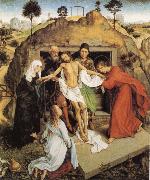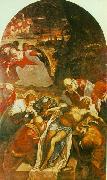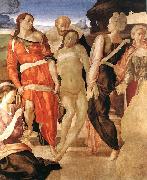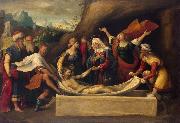Wholesale Oil Painting No Minimum |
|||||||||||
|
|
|||||||||||

|
|||||||||||
|
|
|
||||||||
Albrecht AltdorferGerman 1480-1538 Albrecht Altdorfer Galleries He most often painted religious scenes, but is mainly famous as the first frequent painter of pure landscape, and also compositions dominated by their landscape. Taking and developing the landscape style of Lucas Cranach the Elder, he shows the hilly landscape of the Danube valley with thick forests of drooping and crumbling firs and larches hung with moss, and often dramatic colouring from a rising or setting sun. His Landscape with footbridge (National Gallery, London) of 1518-20 is claimed to be the first pure landscape in oil. He also made many fine finished drawings, mostly landscapes, in pen and watercolour. His best religious scenes are intense, sometimes verging on the expressionistic, and often depict moments of intimacy between Christ and his mother, or others. His most famous religious artwork is the The Legend of St. Sebastian and the Passion of Christ that decorated the altar in the St. Florian monastery in Linz, Austria. He often distorts perspective to subtle effect. His donor figures are often painted completely out of scale with the main scene, as in paintings of the previous centuries. He also painted some portraits; overall his painted oeuvre was not large. |
||||||||
|
|
||||||||
Entombment
Entombment Painting ID:: 2286 |
1518
Art History Museum, Vienna 1518 Art History Museum, Vienna |
|||||||
|
|
||||||||
Roger Van Der Weydenc.1399-1464 Rogier van der Weyden was the son of Henri de le Pasture, a cutler in Tournai, and Agn?s de Watreloz. His birthdate is estimated from the facts that he was stated to be 35 in April 1435 and 43 in September 1441. Before or in 1427 he married Elisabeth Goffaert (c. 1405-77), whose father was a prosperous shoemaker in Brussels. Rogier may have lived for a time in Brussels: his eldest child Cornelis (b 1427) was sometimes referred to as 'de Bruxella' but was not necessarily a native of Brussels. On 5 March 1427 'Rogelet de le Pasture, natif de Tournai' was apprenticed to the Tournai painter Robert Campin. This Rogelet duly completed his apprenticeship in 1431 and on 1 August 1432 became a master of the Tournai guild. Despite much debate, it would appear that Rogelet was Rogier van der Weyden, though it has also been argued that in 1427 Rogier was a married man well past the normal age of apprenticeship and that Rogelet must have been a second Tournai painter of the same name. JACQUES DARET, however, was in his twenties when in 1428 he was apprenticed to Campin, and other instances can be cited of married apprentices. The political situation at Tournai in 1427-8 was unusual, and the guild system was not functioning normally. |
||||||||
|
|
||||||||
|
|
Entombment
Entombment Painting ID:: 33432 |
mk86
c.1450
Oil on panel
110x96cm
Florence,Galleria degli Uffizi
mk86 c.1450 Oil on panel 110x96cm Florence,Galleria degli Uffizi |
||||||
|
|
||||||||
TintorettoItalian Mannerist Painter, ca.1518-1594 His father was a silk dyer (tintore); hence the nickname Tintoretto ("Little Dyer"). His early influences include Michelangelo and Titian. In Christ and the Adulteress (c. 1545) figures are set in vast spaces in fanciful perspectives, in distinctly Mannerist style. In 1548 he became the centre of attention of artists and literary men in Venice with his St. Mark Freeing the Slave, so rich in structural elements of post-Michelangelo Roman art that it is surprising to learn that he had never visited Rome. By 1555 he was a famous and sought-after painter, with a style marked by quickness of execution, great vivacity of colour, a predilection for variegated perspective, and a dynamic conception of space. In his most important undertaking, the decoration of Venice's Scuola Grande di San Rocco (1564 C 88), he exhibited his passionate style and profound religious faith. His technique and vision were wholly personal and constantly evolving. |
||||||||
|
|
||||||||
|
|
Entombment
Entombment Painting ID:: 51003 |
1592-94
Oil on canvas,
288 x 166 cm 1592-94 Oil on canvas, 288 x 166 cm |
||||||
|
|
||||||||
Michelangelo Buonarrotib Caprese 1475 d Rome 1564 Born: March 6, 1475 Caprese, Italy Died: February 18, 1564 Rome, Italy Italian artist Michelangelo was one of the greatest sculptors of the Italian Renaissance and one of its greatest painters and architects. Early life Michelangelo Buonarroti was born on March 6, 1475, in Caprese, Italy, a village where his father, Lodovico Buonarroti, was briefly serving as a Florentine government agent. The family moved back to Florence before Michelangelo was one month old. Michelangelo's mother died when he was six. From his childhood Michelangelo was drawn to the arts, but his father considered this pursuit below the family's social status and tried to discourage him. However, Michelangelo prevailed and was apprenticed (worked to learn a trade) at the age of thirteen to Domenico Ghirlandaio (1449?C1494), the most fashionable painter in Florence at the time. After a year Michelangelo's apprenticeship was broken off. The boy was given access to the collection of ancient Roman sculpture of the ruler of Florence, Lorenzo de' Medici (1449?C1492). He dined with the family and was looked after by the retired sculptor who was in charge of the collection. This arrangement was quite unusual at the time. Early works Michelangelo's earliest sculpture, the Battle of the Centaurs (mythological creatures that are part man and part horse), a stone work created when he was about seventeen, is regarded as remarkable for the simple, solid forms and squarish proportions of the figures, which add intensity to their violent interaction. Soon after Lorenzo died in 1492, the Medici family fell from power and Michelangelo fled to Bologna. In 1494 he carved three saints for the church of San Domenico. They show dense forms, in contrast to the linear forms which were then dominant in sculpture. Rome After returning to Florence briefly, Michelangelo moved to Rome. There he carved a Bacchus for a banker's garden of ancient sculpture. This is Michelangelo's earliest surviving large-scale work, and his only sculpture meant to be viewed from all sides. In 1498 the same banker commissioned Michelangelo to carve the Piet?? now in St. Peter's. The term piet?? refers to a type of image in which Mary supports the dead Christ across her knees. Larger than life size, the Piet?? contains elements which contrast and reinforce each other: vertical and horizontal, cloth and skin, alive and dead, female and male. Florence On Michelangelo's return to Florence in 1501 he was recognized as the most talented sculptor of central Italy. He was commissioned to carve the David for the Florence Cathedral. Michelangelo's Battle of Cascina was commissioned in 1504; several sketches still exist. The central scene shows a group of muscular soldiers climbing from a river where they had been swimming to answer a military alarm. This fusion of life with colossal grandeur henceforth was the special quality of Michelangelo's art. From this time on, Michelangelo's work consisted mainly of very large projects that he never finished. He was unable to turn down the vast commissions of his great clients which appealed to his preference for the grand scale. Pope Julius II (1443?C1513) called Michelangelo to Rome in 1505 to design his tomb, which was to include about forty life-size statues. Michelangelo worked on the project off and on for the next forty years. Sistine Chapel In 1508 Pope Julius II commissioned Michelangelo to decorate the ceiling of the chief Vatican chapel, the Sistine. The traditional format of ceiling painting contained only single figures. Michelangelo introduced dramatic scenes and an original framing system, which was his earliest architectural design. The chief elements are twelve male and female prophets (the latter known as sibyls) and nine stories from Genesis. Michelangelo stopped for some months halfway along. When he returned to the ceiling, his style underwent a shift toward a more forceful grandeur and a richer emotional tension than in any previous work. The images of the Separation of Light and Darkness, and Ezekiel illustrate this greater freedom and mobility. After the ceiling was completed in 1512, Michelangelo returned to the tomb of Julius and carved a Moses and two Slaves. His models were the same physical types he used for the prophets and their attendants in the Sistine ceiling. Julius's death in 1513 halted the work on his tomb. Pope Leo X, son of Lorenzo de' Medici, proposed a marble facade for the family parish church of San Lorenzo in Florence to be decorated with statues by Michelangelo. After four years of quarrying and designing the project was canceled. Medici Chapel In 1520 Michelangelo was commissioned to execute the Medici Chapel for two young Medici dukes. It contains two tombs, each with an image of the deceased and two allegorical (symbolic) figures: Day and Night on one tomb, and Morning and Evening on the other. A library, the Biblioteca Laurenziana, was built at the same time on the opposite side of San Lorenzo to house Pope Leo X's books. The entrance hall and staircase are some of Michelangelo's most astonishing architecture, with recessed columns resting on scroll brackets set halfway up the wall and corners stretched open rather than sealed. Poetry Michelangelo wrote many poems in the 1530s and 1540s. Approximately three hundred survive. The earlier poems are on the theme of Neoplatonic love (belief that the soul comes from a single undivided source to which it can unite again) and are full of logical contradictions and intricate images. The later poems are Christian. Their mood is penitent (being sorrow and regretful); and they are written in a simple, direct style. Last Judgment In 1534 Michelangelo left Florence for the last time, settling in Rome. The next ten years were mainly given over to painting for Pope Paul III (1468?C1549). |
||||||||
|
|
||||||||
|
|
Entombment
Entombment Painting ID:: 62905 |
1510 Tempera on wood, 159 x 149 cm National Gallery, London Both the attribution and the datation is doubtful. It is probable that the painting was executed by a pupil of Michelangelo with the active participation of the master. Artist: MICHELANGELO Buonarroti Title: Entombment Date: 1501-1550 Italian , painting : religious 1510 Tempera on wood, 159 x 149 cm National Gallery, London Both the attribution and the datation is doubtful. It is probable that the painting was executed by a pupil of Michelangelo with the active participation of the master. Artist: MICHELANGELO Buonarroti Title: Entombment Date: 1501-1550 Italian , painting : religious |
||||||
|
|
||||||||
Garofalo1481-1559 Italian Garofalo Gallery Italian painter. Active mainly in Ferrara and the district around the Po delta, he was one of the most outstanding figures in Emilian classicism during the first half of the 16th century. In 1497 Garofalo father paid Boccaccio Boccaccino to teach his son the rudiments of painting. Garofalo first works were directly influenced by the Cremonese painter, to whom they were formerly even attributed. They consist of a series of small paintings depicting the Virgin and Child. The example in the Ca d Oro in Venice must have been Garofalo first painting and reveals not only the lessons learned from Boccaccino, but also signs of the influence of Domenico Panetti (c. 1460-before 1513), traditionally recorded as his first master. Another Virgin and Child (Assisi, Perkins priv. col.) shows signs of the early influence of Lorenzo Costa the elder, while the example in the Nationalmuseum, Copenhagen, shows a similarity with the early works of his contemporary, Lodovico Mazzolino. A particularly important project in Ferrara during the earliest years of the 16th century, involving numerous highly skilled artists, was the fresco decoration of the oratory of the Concezione. The frescoes (Ferrara, Pin. N.) represent a significant development in the city art. Garofalo hand has been identified in the Presentation in the Temple, in which he reveals a familiarity not only with local art, but also with the high points of Bolognese classicism, whose greatest exponents were Francesco Francia and Lorenzo Costa the elder. Around 1505, Garofalo works show a close familiarity with artistic developments in Bologna, in particular the mature style of Costa and the decoration in 1505-6, by Francesco Francia, Costa, Aspertini and others, of the oratory of S Cecilia in S Giacomo Maggiore. Garofalo Virgin Enthroned between SS Martin and Rosalia (Florence, Uffizi), created for Codigoro Cathedral, should be seen within this context, whereas the small altarpiece for the Arcivescovado, Ferrara, although executed at the same time, shows early, if faint, signs of the influence of Venetian painting of the period. |
||||||||
|
|
||||||||
|
|
Entombment
Entombment Painting ID:: 92560 |
1520s
Oil on canvas, 53 x 76 cm
TTD 1520s Oil on canvas, 53 x 76 cm TTD |
||||||
|
|
||||||||
|
Garofalo 1481-1559 Italian Garofalo Gallery Italian painter. Active mainly in Ferrara and the district around the Po delta, he was one of the most outstanding figures in Emilian classicism during the first half of the 16th century. In 1497 Garofalo father paid Boccaccio Boccaccino to teach his son the rudiments of painting. Garofalo first works were directly influenced by the Cremonese painter, to whom they were formerly even attributed. They consist of a series of small paintings depicting the Virgin and Child. The example in the Ca d Oro in Venice must have been Garofalo first painting and reveals not only the lessons learned from Boccaccino, but also signs of the influence of Domenico Panetti (c. 1460-before 1513), traditionally recorded as his first master. Another Virgin and Child (Assisi, Perkins priv. col.) shows signs of the early influence of Lorenzo Costa the elder, while the example in the Nationalmuseum, Copenhagen, shows a similarity with the early works of his contemporary, Lodovico Mazzolino. A particularly important project in Ferrara during the earliest years of the 16th century, involving numerous highly skilled artists, was the fresco decoration of the oratory of the Concezione. The frescoes (Ferrara, Pin. N.) represent a significant development in the city art. Garofalo hand has been identified in the Presentation in the Temple, in which he reveals a familiarity not only with local art, but also with the high points of Bolognese classicism, whose greatest exponents were Francesco Francia and Lorenzo Costa the elder. Around 1505, Garofalo works show a close familiarity with artistic developments in Bologna, in particular the mature style of Costa and the decoration in 1505-6, by Francesco Francia, Costa, Aspertini and others, of the oratory of S Cecilia in S Giacomo Maggiore. Garofalo Virgin Enthroned between SS Martin and Rosalia (Florence, Uffizi), created for Codigoro Cathedral, should be seen within this context, whereas the small altarpiece for the Arcivescovado, Ferrara, although executed at the same time, shows early, if faint, signs of the influence of Venetian painting of the period. Entombment 1520s Oil on canvas, 53 x 76 cm TTD |
||||||||
|
|
||||||||
|
Prev Next
|
||||||||
|
|
||||||||
|
Related Paintings to Garofalo :. |
||||||||
|
|
||||||||
|
CONTACT US |





